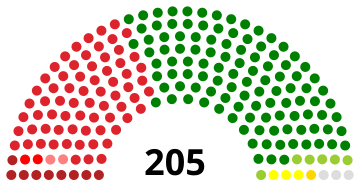|
1991 Nepalese general election
1991 Nepalese general election|
|
|
|
| Turnout | 65.15% |
|---|
|
|
|
General elections were held in Nepal on 12 May 1991, to elect 205 members to the House of Representatives. The elections were the first multi-party elections since 1959 and were a result of the 1990 revolution forcing King Birendra to restore a multi-party system. [1][2]
Although the Nepali Congress won the most seats, its leader Krishna Prasad Bhattarai lost in his own constituency, Kathmandu 1. Communist leader Madan Kumar Bhandari was elected in both Kathmandu 1 and Kathmandu 5, vacating the latter.[3]
Results
 |
|---|
| Party | Votes | % | Seats |
|---|
| Nepali Congress | 2,752,452 | 39.50 | 110 | | Communist Party of Nepal (Unified Marxist–Leninist) | 2,040,102 | 29.27 | 69 | | Rastriya Prajatantra Party (Chand) | 478,604 | 6.87 | 3 | | Rashtriya Prajatantra Party (Thapa) | 392,499 | 5.63 | 1 | | United People's Front of Nepal | 351,904 | 5.05 | 9 | | Nepal Sadbhavana Party | 298,610 | 4.28 | 6 | | Communist Party of Nepal (Democratic) | 177,323 | 2.54 | 2 | | Nepal Workers Peasants Party | 91,335 | 1.31 | 2 | | Rastriya Janamukti Party | 34,509 | 0.50 | 0 | | Communist Party of Nepal (Burma) | 16,698 | 0.24 | 0 | | Janata Dal (Samajbadi Prajatantrik) | 5,760 | 0.08 | 0 | | Nepal Rastriya Jana Party | 5,732 | 0.08 | 0 | | Communist Party of Nepal (Amatya) | 4,846 | 0.07 | 0 | | Rastriya Janata Party (H) | 4,406 | 0.06 | 0 | | Rastriya Janata Party (Nepal) | 4,280 | 0.06 | 0 | | Nepal Conservative Party | 2,562 | 0.04 | 0 | | Bahu Jana Janatadal | 2,012 | 0.03 | 0 | | Janawadi Morcha Nepal | 1,518 | 0.02 | 0 | | Ekata Party | 94 | 0.00 | 0 | | Dalit Majdoor Kisan Party | 92 | 0.00 | 0 | | Independents | 303,723 | 4.36 | 3 | | Total | 6,969,061 | 100.00 | 205 | | | Valid votes | 6,969,061 | 95.58 | |
|---|
| Invalid/blank votes | 322,023 | 4.42 | |
|---|
| Total votes | 7,291,084 | 100.00 | |
|---|
| Registered voters/turnout | 11,191,777 | 65.15 | |
|---|
| Source: Nohlen et al., IFES |
Aftermath
Following the result of the election, Nepali Congress came to power and Girija Prasad Koirala became Prime Minister.[4] The house met for the first time in May 1991. Daman Nath Dhungana served as the Speaker of the House.[5] The parliament could not complete its full five-year term with Koirala asking King Birendra to dissolve the house in July 1994 after losing a no-confidence motion with some member of his own party voting against him.[6][7]
See also
References
|
|